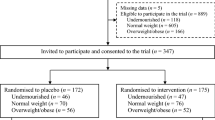Abstract
Objective: To determine the relationship between infant feeding history and risk of xerophthalmia due to vitamin A deficiency (VAD) in early childhood. Design: A case-control study of previously xerophthalmic and non-xerophthalmic children. Setting: Rural lowland region of Nepal. Subjects: One hundred and fifty-six children (aged 1–6 y old), half of whom previously had xerophthalmia due to vitamin A-deficiency, the other half matched by locale, age and the presence and age of a younger sibling (n=102). Methods: Xerophthalmia was determined by trained ophthalmic assistants on the basis of current Bitot’s spots, corneal xerosis or report of night blindness. Infant feeding history was collected through a diet history method obtained from the mother of the focus child. Exploratory factor analysis was conducted to determine the presence of underlying patterns in infant feeding practices. Conditional logistic regression was used to estimate odds ratios. Results: Mothers of control children tended to have a higher level of education (P<0.10) and to have fewer children who had died (P<0.10) than mothers of case children. Feeding of meat (OR=0.09, CI=0.01–0.70) or fish (OR=0.41, CI=0.17–0.99) with liver, eggs (OR=0.11, CI=0.01–0.88) and mango (OR=0.28, CI=0.13–0.60) were protective in association with xerophthalmia in early childhood. Factor analysis uncovered several distinct patterns in infant feeding, which varied by age of the infant. Only the ‘animal flesh’ feeding pattern (factor), practiced in the second year of life, proved significantly protective from xerophthalmia (OR=0.43, CI=0.20–0.94). Feeding patterns of younger children closely paralleled those of their older siblings with and without VAD. Conclusions: The study supports the hypothesis that infant dietary practices can influence subsequent risk for VAD. Our findings emphasize the importance of introducing vitamin A-rich foods during weaning to reduce the risk of VAD-associated xerophthalmia in the later preschool years. Sponsorship: The project is funded through Cooperative Agreement No. DAN 0045-A-00-5094-00 between the Center for Human Nutrition/Dana Center for Preventive Ophthalmology, The Johns Hopkins University and The Office of Health and Nutrition, US Agency for International Development, with additional support from Task Force Sight and Life (Roche, Basel), and NIH shared instrument grant No. S10-RR 04060.
This is a preview of subscription content, access via your institution
Access options
Subscribe to this journal
Receive 12 print issues and online access
$259.00 per year
only $21.58 per issue
Buy this article
- Purchase on Springer Link
- Instant access to full article PDF
Prices may be subject to local taxes which are calculated during checkout
Similar content being viewed by others
Author information
Authors and Affiliations
Rights and permissions
About this article
Cite this article
Gittelsohn, J., Shankar, A., Jr, K. et al. Infant feeding practices reflect antecedent risk of xerophthalmia in Nepali children. Eur J Clin Nutr 51, 484–490 (1997). https://doi.org/10.1038/sj.ejcn.1600435
Received:
Revised:
Accepted:
Issue Date:
DOI: https://doi.org/10.1038/sj.ejcn.1600435



